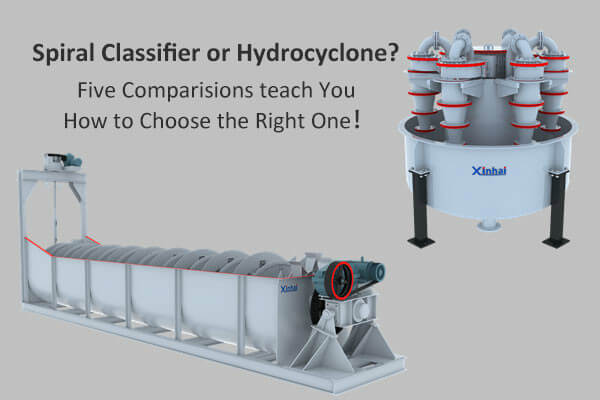

Warm Tip: If you want to know more details about equipment, solutions, etc, please click the button below for free consultation, or leave your requirements!
In this post, we are going to talk about how to choose spiral classifier and hydrocyclone.
The following will compare the spiral classifier and the hydrocyclone from 5 aspects:
Material Nature
Floor Area
Classification Efficiency
Operation
Investment Costs
Let's dive right in!

Nowadays, spiral classifier and hydrocyclone are considered to be the two mainstream classification equipment. As the first generation of classification equipment, the spiral classifier has been widely used in mineral processing plants for decades. While as the second generation classification equipment, the hydrocyclone quickly occupied a market place in the classification equipment of dressing plants with their unique advantages. Many people are puzzled that since both are mainstream classification equipment, what is the difference between them? And which type of classification equipment should I choose?
The common spiral classifiers include both high dam spiral classifier and submerged spiral classifier. High dam spiral classifiers are usually applied to classification of coarse-grain particles, generally with classification overflow particle size larger than 0.15 mm. The submerged spiral classifier is suitable for fine particle classification, and the classificaiton overflow particle size is generally less than 0.15 mm. Compared with these two kinds of spiral classifiers, the hydrocyclone has a better classification effect when classifying finer-grained materials (the classifying size is generally 0.3-0.01 mm).
It is obvious that the floor area of hydrocyclone is significantly smaller than that of the spiral classifier. Usually, the hydrocyclone covers an area of only l/30 to l/50 to the spiral classifier. The equipment floor area requirement also limits the application of the spiral classifier to a certain extent.
The spiral classifier is superior to the hydrocyclone in terms of both classification efficiency and product accuracy. A large part of the reason is that if the pressure is not up to standard, the hydrocyclone will change the position of the final material discharge. It’s necessary for hydrocyclones to rotate at a low speed by a spiral to agitate the slurry to suspend the fine particles, and overflow to the overflow dam. The coarse particles sink to the bottom of the tank and are transported by the screw to the discharge port for discharge. The hydrocyclone has to discharge at the side opposite the inlet, that is, once the pressure is not up to standard, the material delamination will be disordered, so that the material cannot be discharged normally from the outlet. However, this is not absolute, especially when the size of the classification is very fine (such as 0.037 mm), the classification efficiency of the hydrocyclone is significantly higher than other main classification equipment.
The biggest reasons why the spiral classifier is most widely used lie in its simple structure, stable operation and easy operation. It is because of the simple operation process and stable working state that the cost for maintenance and replacement of equipment is greatly reduced and the completion time is guaranteed, making the classification operation more guaranteed. In addition, its easy-to-operate feature allow the operator to operate the hydrocyclone after a short-term training session. In other words, it has relatively low technical requirements for the operator. Relatively speaking, the operation of the hydrocyclone is more complicated, since the ore pressure, concentration and particle size will greatly affect the classification index. So there is higher requirement for the accuracy of the operation.
In terms of equipment investment, the equipment price of the hydrocyclone is definitely lower than that of the spiral classifier. However, in addition to hydrocyclone itself, there still requires a series of necessary auxiliary equipment for hydrocyclone, such as dispensers, valves, pumps, etc., which increases the investment of some equipment. In terms of maintenance, the wear parts of hydrocyclones are mainly lining and overflow pipes. Of course, the frequency and extent of wear are caused by factors such as particle size, shape, and solid content. Therefore, the service life and maintenance cost can only be accurately obtained in the actual plant selection practice. The maintenance aspect of the spiral classifier is mainly to replace the spiral lining, as well as other routine maintenance. However, because the lining material of spiral classifier is relatively expensive, spiral classifier purchase and maintenance costs are high. Overall, the investment price of the spiral classifier is higher than that of the hydrocyclone.
Classifier is combined with the grinding equipment in the beneficiation production line to jointly provide the ore of suitable size for the separation operation. The choice of any mineral processing equipment will not be unilaterally determined, it must be the result of comprehensive consideration. An overall consideration will not only help to improve production efficiency, but also help to obtain the best return on investment.
The above mainly compares the spiral classifier and the hydrocyclone in terms of material properties, floor space, grading efficiency, operation and investment cost, each of which has advantages and disadvantages. When selecting a classifying equipment, you can consider the characteristics of different equipment to select the one that meets the actual production.
18 Technical Parameters of Hydrocyclone
 53
53
 3706
3706
2Common Types of Spiral Classifier Used in the Mineral Processing

 4696
4696


What Are the Differences Between CIP and CIL?
 10407
10407
 0
0